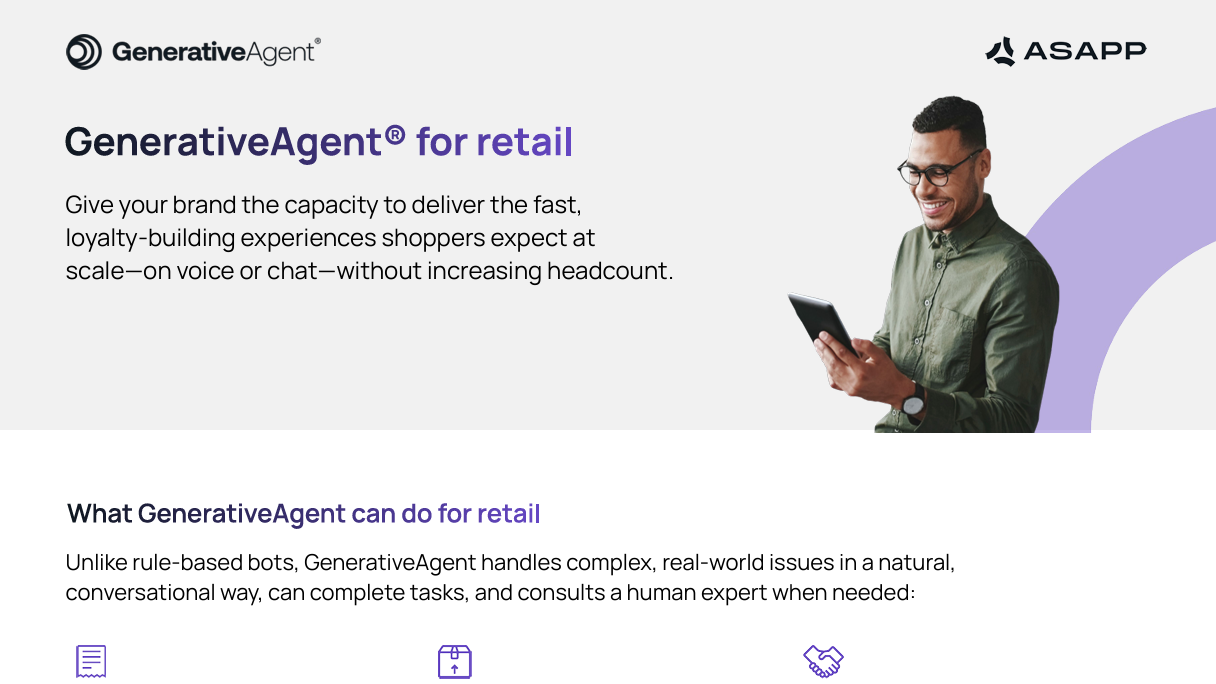Customer service teams in retail are constantly under strain to deliver, facing higher customer expectations, more complex interactions, and increased pressure to reduce operating costs further. CX models that put the burden squarely on human agents or rely on basic bots can struggle to keep up with the massive demand for high-quality service.
That’s where generative AI can be effective—if used right. Unlike legacy automation tools, generative AI agents have the capability to respond to customer needs in real time and take actions to resolve customers' problems—from cancellations and refund requests to answering nuanced product questions. Instead of a rigid, pre-determined conversation flow, AI agents can respond naturally and resolve issues quickly throughout the customer journey.
An important first step is to identify and choose the right use cases to get the most out of these generative AI agents. This will not only allow you to prove the value of deployment quickly, but also rally internal support to expand use cases.
Here are 8 high-impact use cases where you can benefit the most by putting generative AI agents to work in retail:
1. Streamlining returns, refunds, and exchanges
Returns and refunds are among the most common (and often the most frustrating) customer service interactions. Nobody wants to be put on hold or be stuck with a chatbot after receiving the wrong product or something that doesn’t meet expectations. What customers want at that moment is a fast resolution to get their money back.
Instead of a long wait, customers can receive help from a generative AI agent immediately to complete their requests. With access to backend systems and your knowledge base, autonomous AI agents can check return eligibility, verify order details, generate a shipping label, and even suggest exchange options—all in an experience that’s straightforward for customers.
This turns a potentially bad experience into a quick, easy conversation, helping you gain customers’ trust and encouraging them to return in the future.
2. Answering order questions—before escalation is needed
“Where’s my order?” doesn’t have to lead to long wait times, endless prompts, or email back-and-forth. A generative AI agent can retrieve real-time order status, handle delivery delays, and even update shipping details—no awful hold music or frustrating menu navigation required.
If things do go wrong, like missing items or shipping errors, an AI agent can also help triage and resolve issues on its own, or if needed, seamlessly hand off the interaction to a human.
Taking it one step further, the AI agent can provide all the necessary context of the customer conversation, so the human agent can pick it up where things were left off without asking, “Can you repeat your order number again?”
3. Scaling effortlessly during seasonal peaks
Holidays, promotions, and new product launches can significantly drive up call and chat volumes, making it both difficult and expensive to predict and keep up with demand.
Because an AI agent can scale automatically when demand surges, it can handle thousands of conversations simultaneously. This means that when customers call in, their calls are answered right away. This helps teams maintain a high level of service even during peak times while preventing loss of revenue due to customers waiting too long to get answers.
This also helps teams avoid over-hiring or burning out the existing customer support team.
4. Enabling upsell opportunities
One of the most overlooked benefits of AI-driven service in retail is its ability to drive revenue. When customers reach out for support, a generative AI agent can reliably suggest complementary products, highlight current promotions, and guide customers toward relevant purchases. This is especially helpful for companies with extensive product catalogs.
For example, if a customer returns an item and needs help finding a replacement, the AI agent can make personalized recommendations and even handle the purchase if integrated with the necessary systems.
5. Making loyalty programs more accessible
Loyalty programs are only effective if customers understand them and can use them easily, without confusing rules or difficult enrollment steps. An AI agent can help make these programs much more accessible by explaining how the rewards work, checking point balances, enrolling customers, and applying promotions.
This makes it easier for customers to take advantage of the program and, in turn, helps the company build real customer loyalty.
Even during high-volume periods, the AI agent can consistently offer loyalty options without increasing pressure on frontline teams.
6. Handling product and policy questions with context
Customers don’t always stick to the script. They ask real questions that demand more than predetermined conversation flows: “Is this jacket available in my store?” “Can I use a coupon on this sale item?” “Will this remote work with my smart TV at home?”
Generative AI agents can answer these questions in plain, natural language by referencing the company’s data, policies, and inventory in real time. Even if rules vary by region or product category, or if they were updated just yesterday, the AI agent can keep up, without getting confused or sending customers in circles.
7. Providing always-on, around-the-clock support
Customer questions don’t stop after hours—and generative AI doesn’t stop serving, either.
AI agents are always available, whether it’s a midnight delivery issue or a Sunday search for the right product. This availability not only improves customer satisfaction, but also helps reduce pressure on your after-hours teams and prevent long hold times during nights or holidays.
8. Delivering consistent, brand-aligned experiences
Maintaining consistency across channels, locations, and agents is a constant challenge for retail contact centers, especially when agent turnover is high.
A generative AI agent can deliver consistent, on-brand service by drawing from the company’s knowledge base, product catalog, and policies. Whether it’s answering a shipping question or suggesting a product, it provides accurate, reliable responses. It can also personalize them using customer history or preferences when available.
What to look for in a generative AI agent for retail
If you’re exploring generative AI agents, focus on practical capabilities, not just hype. Here are three things to look for:
Easy API integration
AI agents should plug into your existing systems, such as order management, CRM, inventory, and loyalty, without weeks of custom development. Solutions that support flexible API integration, including tools for API transformation or adaptation, will make it easier to connect even with legacy systems.
When integration is limited, look for solutions that support human-in-the-loop collaboration with an intuitive workspace, so a human expert can support and guide the AI without completely taking over the interaction.
Human-in-the-loop capabilities
Not every conversation requires escalation. But sometimes a bit of human input can make all the difference. Choose AI agents that allow for real-time human-in-the-loop expert guidance without interrupting or handing off the customer interaction entirely.
Built-in QA and analytics
To scale successfully, you need visibility. Look for AI platforms that include robust conversation analytics, quality assurance tools, and clear insights into what's working and what’s not. That way, you can continuously refine and optimize your AI agent’s performance based on real data.
Testing and simulation
Due to its generative nature, you can’t spot check an AI agent and call it a day if the first handful of responses meet your expectations. Look for a solution that provides ways to set up realistic customer interaction scenarios. It’s even better if these tools are no-code, so you don’t need to rely on your engineering or IT teams to set them up.
Only with proper testing and simulation can you confidently deploy the AI agent in front of your customers.
Final thoughts
Generative AI is showing new possibilities for retailers to improve customer experience while increasing service capacity. Generative AI agents can give your team a smarter, more scalable way to deliver fast, helpful service, without compromising quality.
With the right setup and AI agent, you can deliver retail customer service that’s faster, more personal, and easier to scale.




